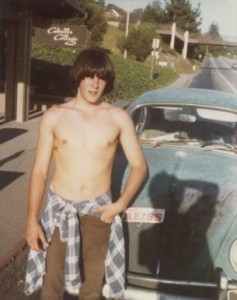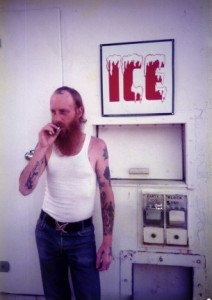Doug Biggert at White Columns
The romance of the road has been an American cultural staple for much of the last century. In its romantic coinage it has been less young frontiersman going west to settle the for spacious land and more drifter, beatnik or hippie aimlessly ricocheting from place to place. In this latter guise the road has also been a romantic staple of the European glance toward America. Robert Frank may have genuinely gone looking for an America he did not know (and invented a photographic genre en-route). He may indeed have been “Swiss, unobtrusive, nice” and he surely “sucked a sad poem right out of America”. But his body of work has made America difficult to be photographically known in any other way. It has been almost impossible for Frank’s trailing caravan of Europeans to not find Enigmatic scraps of architecture in desertscapes, seemingly arcane rituals of regional Americans, and shards of kitsch culture highjacking the continent. Now, in a curious twist on this cultural dialogue, Doug Biggert, an American photographer of the road has been ‘discovered’ by Europeans to be repackaged for the home team.
A chance encounter in Sacramento California, where Biggert lives, between the photographer and Xavier Carcelle and Chloe Colpe, two French tourists led, with various transatlantic comings and goings to a show of Biggert’s work in Paris the publication of the book “hitch-hikers” and a documentary film, “Beautiful America”, (2008), about the photographer and his project. Said project is an ongoing habit –the word seems right– of picking up hitchhikers and photographing them. Biggert has been doing this since the 1970’s. Perhaps I am falling for the pitch here, but it is as if Carcelle and Colpe discovered an ‘outsider photographer’. Yes there is much mythologiziing of Biggert and his ways. He shot the images on a cheap Kodak Instamatic camera. He had the film processed at Walmart, kept the 4×6 color prints and tossed the negatives. He kept the prints in an old shoebox and he apparently scoffs at the idea of his being an artist.
 Hmm? The images then: In the current white columns show a selection of some forty prints from the hitchhiker series –which numbers depending upon your source from 350 to thousands of images- occupy one of the white room spaces. Smallish, though not the 4×6 machine prints of the myth, each image shows a figure cropped variously from knees or waist. Sometimes a full figure is framed. Many (most) stare directly at the camera clearly aware they are being photographed. Numerous times Biggert’s battered old Volkswagen bug shares space with the figure. The road is nearly always visible in some manner. There is almost always crowded space around the figure. And the images come, inevitably, to be about the relationship of the posing figures to that crowded space. Shot seemingly, casually and presumably wherever Biggert picked the person up or dropped them off, Biggert’s photographic subjects are surrounded by a random catalogue of bumper stickers, T shirts, commercial signs, logos, backpacks, musical instruments, sneakers and very American bric a brac. And, given the time frame of the shooting –the 1970’s– the hair, the cuffs of the pants, the buttons on the shirts, the absence of shirts, the cigarettes, the joints (?) all become the busy, cluttering epiphenomena of Biggert’s American road. Indeed if these people were nouns they would be awash in adjectives.
Hmm? The images then: In the current white columns show a selection of some forty prints from the hitchhiker series –which numbers depending upon your source from 350 to thousands of images- occupy one of the white room spaces. Smallish, though not the 4×6 machine prints of the myth, each image shows a figure cropped variously from knees or waist. Sometimes a full figure is framed. Many (most) stare directly at the camera clearly aware they are being photographed. Numerous times Biggert’s battered old Volkswagen bug shares space with the figure. The road is nearly always visible in some manner. There is almost always crowded space around the figure. And the images come, inevitably, to be about the relationship of the posing figures to that crowded space. Shot seemingly, casually and presumably wherever Biggert picked the person up or dropped them off, Biggert’s photographic subjects are surrounded by a random catalogue of bumper stickers, T shirts, commercial signs, logos, backpacks, musical instruments, sneakers and very American bric a brac. And, given the time frame of the shooting –the 1970’s– the hair, the cuffs of the pants, the buttons on the shirts, the absence of shirts, the cigarettes, the joints (?) all become the busy, cluttering epiphenomena of Biggert’s American road. Indeed if these people were nouns they would be awash in adjectives.
Hitchhiker, date unknown is the identifying label used for many of the photographs. One such image –background details signaling furiously– shows the male figure dragging hard on a cigarette between hippie beard and mustache while the motel ice machine has his back. His heavily tattooed arms are Illustrated Man material while the belt buckle dovetails with some Easy Rider fantasy. Another image, same Untitled, date unknown, offers a younger man bare chested with plaid shirt knotted around his waist, shaggy beetle-cut hair, road vanishing in the distance behind him while Biggert snags his own shadow across the hood of the battered VW. Another, same Untitled, date unknown: two women, one reaching back into the VW the other facing the photographer. The latter wears striped denim, overall shorts –Oshkosh I’ll bet– while the VW’s characteristic curve from roof to trunk to hood pops into Biggert’s flashlit halo and holds the nighttime at bay. Even the paint work of the car –tarnished, dulled to look almost suede– signs the 1970’s for us: the counterculture’s abandonment of consumption reflects in its dulled surface.
 America is an image repository for Europeans. And because of this there is that class of European artists –and spectators– who come to America and find the images they already knew, would be there. Wim Wenders as both photographer and filmmaker of Paris Texas comes to mind. But the relationship, European person to American image, is a complicated two-way dialogue. America has imaged itself so promiscuously and seductively that there are those who were lured from Europe to the U.S. by images of Kojak, (Telly Savalas) on their 1970’s TV screens. Their anti-American horror was fed in parallel by images of the American war in Vietnam drizzling across the TV screen on another channel.
America is an image repository for Europeans. And because of this there is that class of European artists –and spectators– who come to America and find the images they already knew, would be there. Wim Wenders as both photographer and filmmaker of Paris Texas comes to mind. But the relationship, European person to American image, is a complicated two-way dialogue. America has imaged itself so promiscuously and seductively that there are those who were lured from Europe to the U.S. by images of Kojak, (Telly Savalas) on their 1970’s TV screens. Their anti-American horror was fed in parallel by images of the American war in Vietnam drizzling across the TV screen on another channel.
For Carcelle and Colpe one can only imagine what the shoebox stash they discovered with Biggert must have seemed like. A time capsule of the Kojak era? Maybe. Because back then that was how Europeans saw America: literally. The 1970’s itself saw the infancy of cheap air travel but not too many European tourists found their way to the Brobdingnagian shores of America. Biggert’s snapshots, unearthed some thirty years after the fact, by two French tourists in California, domesticate for the foreigner that overwhelming land in retrospect. Biggert’s images provide a suitably stumbling reality effect by describing the peculiar details of hippie America without too complex a new narrative to shake up our foreknowledge.
Yet a crucial distance has been traveled from Biggert’s hippie-dippy, friendly habit of snapping all those hitchhikers he met. In the Paris show, as best one can tell from documentation, large format presentations of the images were made. Supersized American characters stalking the Parisian culturatti. So too, again as best as can be told from the documentation, with the Verge gallery show. At white columns the prints are 11×14 gallery prints.
I do like Biggert’s photographs very much. It is the casualness of them I like. The not particularly thought-aboutness, the un, or awkwardly posed quality the people have. The coincidental presence of all the ephemera, it is all that which excites me about them. And that they are actual artifacts of the 1970’s. In this vein Biggert’s scoff at the artfulness of his work seems well founded. And his images, or rather the mythology around them, remind me that perhaps the most beautiful, most moving photograph I have ever seen –the photograph with the most aura should we say– is one from the Sam Wagstaf collection. I saw it at the Wadsworth Atheneum in Hartford Connecticut in 1977 or 78 (sic). It was a crumpled wallet photo, dog eared and torn. It was a photograph of Bonnie and Clyde. It was an artifact of its moment.
I for one would be happier with the, presumably by this point cracked, dog eared and faded, 4×6 machine prints of Biggert’s work. Those photographs, like the people in them, seem like the artifacts from the time capsule of America’s habit of ‘snapping’ itself. That’s the show I would like to see. Meanwhile I wonder would Biggert scoff at the notion of himself as anthropologist rather than an artist?
Doug Biggert at
white Columns
320 West 13th Street
New York, NY 10014-1219
(212) 924-4212
january 15-february 27 2010






i enjoyed this review, and take comfort that i have the choice of being a photographer or anthropologist.
may i add some information? the pictures date from the seventies into this current century as i am still picking up hitchhikers tho the bug is long gone. one or two or so were actually with an instamatic but before walmart was established. the majority are from several olympus xa’s. all were developed cheaply. the total is nearing 500.
there is another “body of work” (i use a curator’s term i am not fond of) called the sandal shop wall that has only been shown twice. newport harbor art museum in 1972 and the verge galllery, sacramento 2009. all thee were instamatic and there are well over 2,000 from 1969 until 1972, this i love and am quite proud of. at the verge, 40 years later, a young woman recognized her uncle, and was sure because of his small tattoo. makes for quite a show.
doug biggert, october 2010